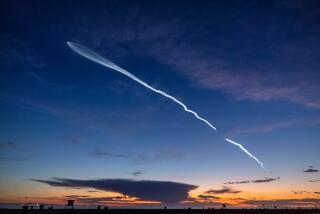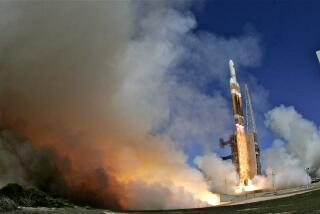Faster than the speed of sound
On Oct. 14, 1947, Air Force Capt. Chuck Yeager became the first person to fly faster than the speed of sound. Yeager shattered the sound barrier by reaching 700 mph (Mach 1.06) in a Bell X-1 jet nicknamed Glamorous Glennis, 42,000 feet above the Mojave Desert. In commemoration of the 50th anniversary, Yeager will do it again Tuesday at 10:29 a.m. and at next weekend’s annual open house and air show at Edwards Air Force Base, this time in an F-15.
Most people know Edwards AFB as the place where the space shuttle lands, but that’s only part of the story. For five decades, Edwards has been the nation’s premiere flight test center and the site of numerous aerospace milestones. In the last 40 years, nearly every Air Force aircraft has been first tested and developed at Edwards, home to the nation’s only test pilot school. Among testing and research facilities at Edwards are NASA’s Dryden Flight Research Facility, Phillips Laboratory, Integrated Facility for Avionic Systems Testing and the Benefield Anechoic Facility.
CREATING A SONIC BOOM
A slow-flying airplane creates pressure disturbances that travel at the speed of sound. These differences in air pressure move ahead of the plane.
A plane flying at the speed of sound moves as quickly as the disturbances it causes. The disturbances stack up in front of the plane and form a shock wave.
A plane flying faster than sound creates a shock wave that reaches the ground. People on the ground hear a sonic boom when the shock wave reaches them.
WHAT IS MACH?
When retired Brig. Gen. Chuck Yeager breaks the sound barrier Tuesday and next Saturday, he will be flying at Mach 1, creating a sonic boom. Mach numbers (named for Austrian physicist Ernst Mach) describe the speed of planes flying near or above the speed of sound, which is about 741 mph at sea level, but decreases at higher altitudes. Mach 1 refers to planes flying at that speed at a given altitude. A jet at Mach 2 is flying at twice the speed of sound, etc...
EDWARDS AIR FORCE BASE
Current personnel: 725 officers; 3,820 enlisted; 9,080 civilians.
Aircraft: 121 based at Edwards.
Lake beds: Rogers and Rosamond dry lake beds, among the prominent features at Edwards AFB, have been used for planned and emergency landings for more than 40 years. Rogers Dry Lake covers 44 square miles. Rosamond Dry Lake covers 21 square miles.
Size: The base extends over 301,000 acres, or 470 square miles, and reaches into Kern, Los Angeles and San Bernardino counties.
Fiscal 1995 total payrolls: military, $353 million; civilian, $843 million.
Edwards’ Future: The X-33
Last month, NASA announced that Edwards AFB is the preferred launching site for the X-33 rocket prototype. The experimental reusable launch vehicle could eventually be a successor to the space shuttle.
50TH ANNIVERSARY OPEN HOUSE AND AIR SHOW
When: October 18 and 19, beginning at 7:30 a.m.
Where: Edwards Air Force Base.
Cost: No charge for admission or parking.
More information: Call (805) 277-6082; or check Edwards’ Web site at www.edwards.af.mil
SELECTED AIR SHOW EVENTS*
10 a.m.: Chuck Yeager sonic-boom flight
10:30 a.m.: Army Golden Knights parachute demonstration (Oct. 18)
10:30 a.m.: U.S. Air Force Academy Wings of Blue parachute demonstration (Oct. 19)
11 a.m.: C-17 low-velocity air drop
11:35 a.m.: F-117 Stealth fighters formation
1 p.m.: T-38 Talon, F-15 Strike Eagle, F-16 Fighting Falcon aerial review
1:15 p.m.: C-130 Hercules, C-141 Starlifter, C-17 Globemaster aerial review
1:20 p.m.: SR-71 Blackbird Mach 3 pass; Air Force Flight Test Center aerial review
1:55 p.m.: SR-71 Blackbird low-altitude pattern and landing
2:20 p.m.: B-2 Spirit Stealth bomber pass
2:35 p.m.: WWII P-51 Mustangs formation flight and demonstration
3 p.m.: USAF Thunderbirds aerial demonstration team
3:30 p.m.: USAF Thunderbirds flying F-16 Fighting Falcons
* Many military and civilian aircraft will be displayed, including a full-size model of the original X-1 that broke the sound barrier
* Schedule subject to change
Sources: Edwards Air Force Base; World Book Encyclopedia; NASA. Researched by JULIE SHEER/Los Angeles Times
More to Read
Sign up for Essential California
The most important California stories and recommendations in your inbox every morning.
You may occasionally receive promotional content from the Los Angeles Times.










